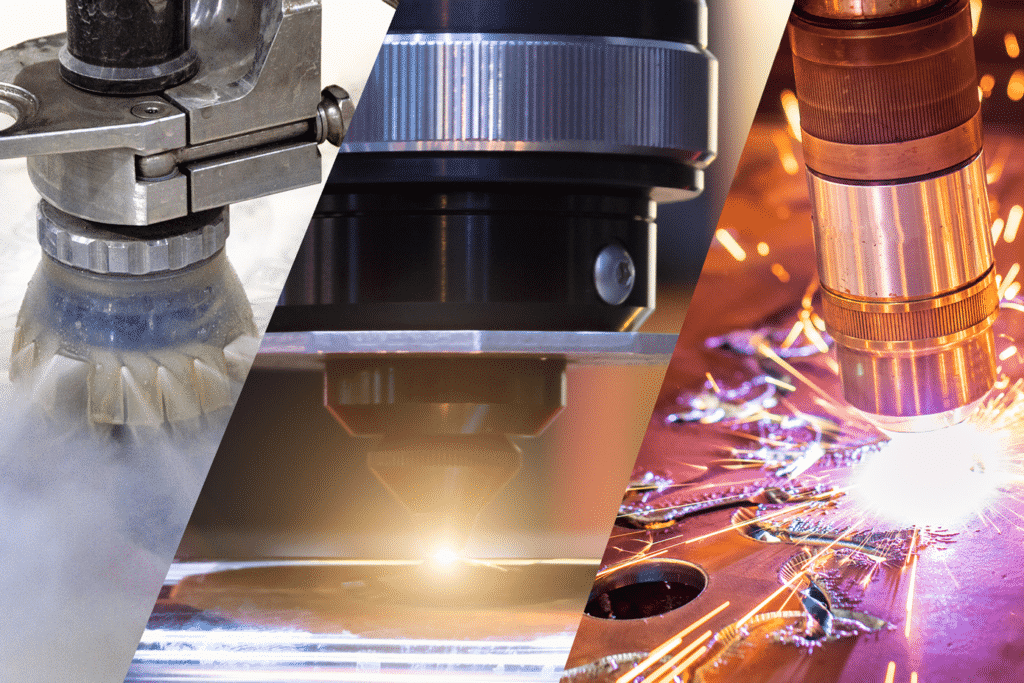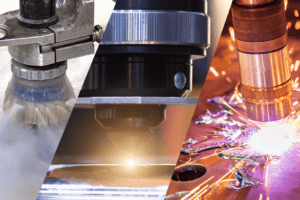Laser is more precise than plasma and the waterjet system and uses less energy when cutting steel and aluminum sheets. Are you torn between choosing a waterjet, laser or plasma cutting system? Each system uses a different method to cut material, and each has its benefits and disadvantages.
It’s not an easy decision to make as there are a lot of factors to consider; the initial outlay and running costs, the efficiency of the system, and the impact on your bottom line, not to mention the staff impact.
A closer look at each method will give a little more insight into the general benefits and disadvantages of each, helping you to make an informed choice. Read on to find out which cutting technology will best suit your business.
How does a Waterjet work?
Waterjet cutting is a cold cutting process using a specialised device or tool to cut with an incredibly high pressure jet of water, which is often combined with an abrasive mineral substance depending on the materials you might be working with.
What can it cut?
The waterjet can basically cut anything; stainless steel, Inconel, titanium, aluminium, tool steel, ceramics, granite, armour plate and materials that are sensitive to high temperatures. It can cut almost any shape with precision, creating a uniform and burr-free edge.
The waterjet uses the same tool for cutting all types of product, so there is no need to change cutting tools when switching product. This system does, however, produce a high volume of cutting waste and requires a high level of clean up, compared to laser.
The nature of the waterjet process requires that protective equipment is worn, particularly ear protection as the machine generates significant noise pollution.
How does a Plasma work?
A range of consumables work together at the business end of a plasma to perform the cutting process. The nozzle gives focus to the plasma arc and funnels the gas flow while the electrode carries the current. Swirl rings work to allow the gasses exiting the rings to be at different temperatures, removing heat from the electrode, the whole assembly is housed within the shields and shield caps.
Plasma cutting requires only minimal operator training and is easy to operate with no potentially complicated adjustments. However, in addition to high energy radiation generated by plasma, the intense heat creates substantial quantities of fumes and smoke from vaporising metal, so again, a well-ventilated work area is a must.
What can it cut?
Plasma can be used for cutting metals such as stainless steel, aluminium and copper, of varying thicknesses. It can cut both ferrous and nonferrous metals, but non-conductive materials such as wood or plastic cannot be cut with a plasma cutter. Plasma is faster than laser cutting systems for thickness over 3mm, but a minor drawback is that plasma typically leaves a 4-6-degree bevel on the cut edge; which can be more noticeable on thicker pieces.
How does a Laser work?
Laser cutting is all about accuracy and efficiency, the nozzle gives incredible focus to the beam of light using a curved lens to create a spherical pinpoint of light aided by compressed gasses. When it is focussed on to material it simply vaporises it into gas, making laser cutting perfect for accuracy and intricacy.
The laser cutting machine requires only minimal human intervention, mainly for programming, inspections and repairs. Therefore, the frequency of injuries and accidents is minimal, although too close contact with the laser can cause burns. Laser cutting of materials such as plastics can cause gas emissions when exposed to heat, which means that a well-ventilated room is vital as the gases can be harmful and toxic.
What can it cut?
The laser is a little more wide-ranging and versatile than plasma in the variety of materials it can cut. All plastics, glass, ceramics, rubber, wood and most metals can be cut with speed and accuracy with a laser. It also allows complex detail and good edge quality in sheet, plate, and tube or box section.
The laser is more precise than plasma and the waterjet system and uses less energy when cutting steel and aluminum sheets. Historically laser cutting has not been as efficient as its plasma counterpart. That is no longer the case thanks to advances in technology.
Those same advances have now made laser machines much more affordable, as a result more and more companies are now using their own in-house laser machines instead of expensive outsourcing.
A final word about efficiency
Power consumption depends on the type of material to be cut but as a general idea the electrical power use for a 1500-watt laser is 20-40kw, for a 20kw, waterjet system the electrical consumption is 22-35 kw and for a 300amp plasma machine, the electrical power use is 55kw.
To learn more about our laser machinery, waterjets and plasma ranges and to see them in action for yourself at one of our three branches, get in touch today.
Published 8th May 2017


